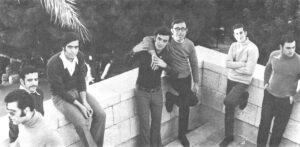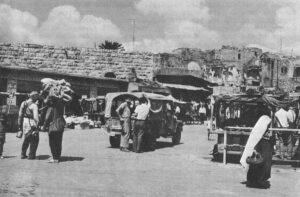Paula Stern
- 1970

Fellowship Title:
- The Contemporary Middle East
Fellowship Year:
- 1970

Is the Problem at the American University of Beirut America?
April, 1971 “I could speak in English, but since I’m at the American University of Beirut, I’ll speak in Arabic,” declared Leila Khaled, the intense Palestinian skyjacker. She had returned this year to the University, where she had studied pharmacy, to speak at one of the weekly campus bull sessions. She went on to denounce – among other things – American imperialism. The American University of Beirut (AUB) – like a lightning rod in a thunderstorm – attracts criticism of United States presence in the turbulent Arab World. The criticism links United States official policies with the ostensibly private, American institution. Samual B. Kirkwood, President of AUB, retorts, “When the University is accused of being a tool of American imperialism, my answer is, ‘Well, if that is so, four thousand people want to come here.’” Some say it is cultural imperialism. Call it what you will, but the fact remains that American influence on this year’s student body of four thousand – plus 14,603 others educated at AUB since its foundation in 1866 – has
On the Receiving End of an Iron Fist in a Velvet Glove
Life is not all politics, war, or guerrilla fighting for a Palestinian living under Israeli military occupation. And today the majority of the world’s Palestinians find themselves under Israeli rule. Israeli statisticians figure there are 974,000 inhabitants of the West Bank of Jordan and the Gaza Strip occupied in the Six Day War, June, 1967, plus approximately 400, 000 Palestinian Arabs who have been Israeli citizens since Israeli independence in 1948 amounting to about one and one half million Palestinians. Officials count between two and one half and three million Palestinians in the world. The Fatmi family is no different from most Arabs under Israeli occupation. Just as Israel’s rule is in general firm yet humane, the Fatmis combine a corpus of hostility toward Israel with a desire for peace. The Fatmis are from Ramallah (population 13,000) on the West Bank. When Ramallah citizens thought they could do something about the Israeli occupation in 1967 and 1968 the town was a center of opposition – strikes, demonstrations, and petitions. It was from Ramallah that the
Palestinian Watches
The Palestinian guerrillas denounce it as a sinister plot. King Hussein doesn’t like it a bit. The Israelis shrug it off as purely an accident, then sit back and smile in satisfaction. Accidentally on purpose, Israel has been changing the occupied West Bank of Jordan and the Gaza Strip – now in their fifth year under Israel – such that if Israel ever returns the territories they will be qualitatively different from when Israel conquered them in 1967. “The area changes naturally as well as willingly on our part,” explained one Israeli official. “The administered territories (Israel’s euphemism for the occupied West Bank of Jordan and the Gaza Strip) are like a watch which we have taken. If after twenty years, we return it, that will not be the same watch. The watch will have dust on it.” The official continued, “Israel’s rule helps people have better lives and lays the ground for peaceful existence.” Indeed, Israel’s economic policy in the area, which emphasizes cooperation between Israel and the occupied territories, has encouraged prosperity among
A Long Shot Approach to Peace in the Middle East
Rogers makes headlines. Sadat makes ultimatums. Golda makes recriminations. And Dayan’s military government in Israel’s occupied territories makes facts. All of these activities, world opinion hopes, are some weird windup to a peaceful follow-through. Ever since June 1967, when Dayan’s army occupied the West Bank of Jordan and the Gaza Strip, home of about half the world’s Palestinians, Israel’s main objective has been security. Nevertheless, the military government has also undertaken civilian responsibilities for their legendary enemies, the Palestinians, with almost as much enthusiasm as when it stormed the area in June 1967. According to the guidelines of the “economic and administrative policies of the Coordinator of Government Operations in the Administered Territories,” Dayan’s Ministry of Defense assumed “…The responsibility of the State of Israel to provide a decent life for the people in the territories. The very fact that the Military administration is the one and only ruler of the area makes it responsible for the welfare of the population.” Assuming responsibility for the welfare of the population stretched the military’s authority to encompass

Arab Bread
When Israel occupied the West Bank of Jordan and the Gaza Strip following the Six-Day War in June 1967, the majority of the world’s Palestinians came under Israeli rule. According to Israeli statistics, the 974,000 Palestinians in the newly-occupied territories plus the approximately 500,000 Palestinian Arabs who had been Israeli citizens ever since Israel gained independence in 1948 total approximately one and one-half million people. The world’s Palestinians number an estimated two and one-half to three million. The West Bank Town Of Hebron. In the war’s aftermath Israel became an occupying military power, and the Arab population, an occupied people. But, while the military government, which has a free hand in what it calls the administered territories, is strict in security matters it has demonstrated flexibility and imagination in civilian affairs. Israel’s pacification program has established – at least for the time being – a relatively peaceful modus vivendi in the area. In particular, it has begun creating a new class of Palestinians dependent upon peaceful cooperation with its number one enemy, Israel, for prosperity.
